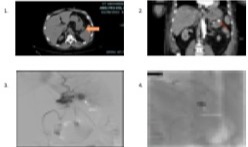Back
Poster Session C - Monday Afternoon
C0339 - Splenic Artery Pseudoaneurysm as a Rare Cause of Upper Gastrointestinal Bleeding
Monday, October 24, 2022
3:00 PM – 5:00 PM ET
Location: Crown Ballroom
- MK
Menasche Krupka, MD
Westchester Medical Center
Valhalla, NY
Presenting Author(s)
Menasche Krupka, MD, Danielle Newbury, BS, Gabriel Heering, MD, Amanda Rupert, MD, Shireen Pais, MD
Westchester Medical Center, Valhalla, NY
Introduction: Upper gastrointestinal bleeding (UGIB) is one of the most common causes for hospital admission in the US. Common etiologies for UGIB include peptic ulcer disease, erosive esophagitis, varices, and less commonly malignancies. Splenic artery pseudoaneurysm (PSA) is a known complication of pancreatitis. It may be asymptomatic or present with left upper quadrant or epigastric pain, and rarely as hemorrhagic shock. Splenic artery PSA presenting with UGIB is extremely unusual.
Case Description/Methods: We present the case of a 57-year-old male with alcohol use disorder complicated by a prior episode of alcoholic pancreatitis, who presented with 3 days of hematemesis, melena, and recurrent syncopal episodes. In the ED his vitals and physical exam were notable for tachycardia, hypotension, and melena. Labs revealed a hemoglobin of 4.2. Non-contrast CT of the abdomen and pelvis showed evidence of blood in the antrum and a 2.0 x 1.6 cm out-pouching from the greater curvature of the stomach which was postulated to be a gastric diverticulum (image 1). Upper endoscopy revealed fresh blood in the antrum and duodenum, as well as a massive adherent clot in the fundus. Since no single site of active bleeding was identified, the patient was started on IV PPI with continued close monitoring in the ICU. He continued to have melena, and increased PRBC requirements. Repeat EGD was performed but was unchanged from prior. A CT angiogram of the abdomen and pelvis demonstrated a 1.5 cm actively bleeding PSA arising from a first divisional branch of the splenic artery communicating with the fundus of the stomach (images 2 & 3). The patient underwent successful coil embolization (image 4). Hemoglobin remained stable throughout the remainder of his admission with no further evidence of bleeding.
Discussion: This case demonstrates PSA as a rare cause of UGIB. Lesions are most commonly caused by chronic pancreatitis, pancreaticobiliary surgery, and trauma. This patient’s PSA was likely secondary to his prior episode of alcoholic pancreatitis. Prompt diagnosis of PSA is essential given the high mortality rate associated with rupture. Clinicians should maintain a high index of suspicion for gastrointestinal PSA in patients with a history of pancreatitis who present with UGIB for whom no obvious source of bleeding can be identified on endoscopy.

Disclosures:
Menasche Krupka, MD, Danielle Newbury, BS, Gabriel Heering, MD, Amanda Rupert, MD, Shireen Pais, MD. C0339 - Splenic Artery Pseudoaneurysm as a Rare Cause of Upper Gastrointestinal Bleeding, ACG 2022 Annual Scientific Meeting Abstracts. Charlotte, NC: American College of Gastroenterology.
Westchester Medical Center, Valhalla, NY
Introduction: Upper gastrointestinal bleeding (UGIB) is one of the most common causes for hospital admission in the US. Common etiologies for UGIB include peptic ulcer disease, erosive esophagitis, varices, and less commonly malignancies. Splenic artery pseudoaneurysm (PSA) is a known complication of pancreatitis. It may be asymptomatic or present with left upper quadrant or epigastric pain, and rarely as hemorrhagic shock. Splenic artery PSA presenting with UGIB is extremely unusual.
Case Description/Methods: We present the case of a 57-year-old male with alcohol use disorder complicated by a prior episode of alcoholic pancreatitis, who presented with 3 days of hematemesis, melena, and recurrent syncopal episodes. In the ED his vitals and physical exam were notable for tachycardia, hypotension, and melena. Labs revealed a hemoglobin of 4.2. Non-contrast CT of the abdomen and pelvis showed evidence of blood in the antrum and a 2.0 x 1.6 cm out-pouching from the greater curvature of the stomach which was postulated to be a gastric diverticulum (image 1). Upper endoscopy revealed fresh blood in the antrum and duodenum, as well as a massive adherent clot in the fundus. Since no single site of active bleeding was identified, the patient was started on IV PPI with continued close monitoring in the ICU. He continued to have melena, and increased PRBC requirements. Repeat EGD was performed but was unchanged from prior. A CT angiogram of the abdomen and pelvis demonstrated a 1.5 cm actively bleeding PSA arising from a first divisional branch of the splenic artery communicating with the fundus of the stomach (images 2 & 3). The patient underwent successful coil embolization (image 4). Hemoglobin remained stable throughout the remainder of his admission with no further evidence of bleeding.
Discussion: This case demonstrates PSA as a rare cause of UGIB. Lesions are most commonly caused by chronic pancreatitis, pancreaticobiliary surgery, and trauma. This patient’s PSA was likely secondary to his prior episode of alcoholic pancreatitis. Prompt diagnosis of PSA is essential given the high mortality rate associated with rupture. Clinicians should maintain a high index of suspicion for gastrointestinal PSA in patients with a history of pancreatitis who present with UGIB for whom no obvious source of bleeding can be identified on endoscopy.

Figure: 1. CT Thx/Abd/Pel demonstrating a 2.0 x 1.6 cm out-pouching from the greater curvature of the stomach (arrow), postulated to be a gastric diverticulum, 2. CT Angiogram Abd/Pel demonstrating the splenic artery PSA (arrow), 3. Fluoroscopic imaging re-demonstrating the splenic artery PSA with extravasation of contrast into the gastric lumen, 4. Splenic Artery PSA after successful coil embolization
Disclosures:
Menasche Krupka indicated no relevant financial relationships.
Danielle Newbury indicated no relevant financial relationships.
Gabriel Heering indicated no relevant financial relationships.
Amanda Rupert indicated no relevant financial relationships.
Shireen Pais: abbvie – Speakers Bureau. boston scientific – Consultant. olympus – Consultant.
Menasche Krupka, MD, Danielle Newbury, BS, Gabriel Heering, MD, Amanda Rupert, MD, Shireen Pais, MD. C0339 - Splenic Artery Pseudoaneurysm as a Rare Cause of Upper Gastrointestinal Bleeding, ACG 2022 Annual Scientific Meeting Abstracts. Charlotte, NC: American College of Gastroenterology.
